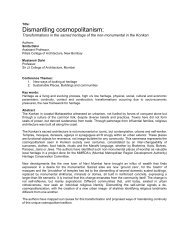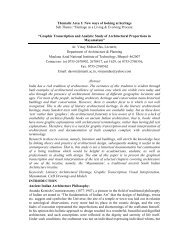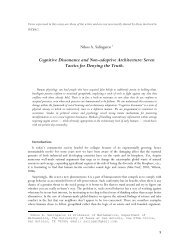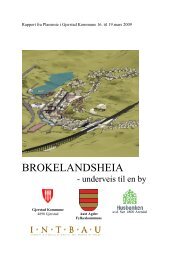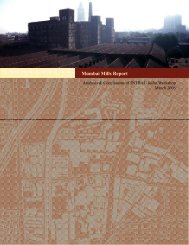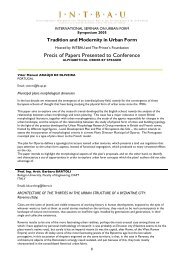Amit Bhatt, Prerna Mehta, Sarika Panda - Intbau
Amit Bhatt, Prerna Mehta, Sarika Panda - Intbau
Amit Bhatt, Prerna Mehta, Sarika Panda - Intbau
You also want an ePaper? Increase the reach of your titles
YUMPU automatically turns print PDFs into web optimized ePapers that Google loves.
1. BackgroundThe world took 1800 years to reach its first billion population, 130 years to reach the secondbillion, while it took just 60 years to cross the five billion mark. Today, more than 50 per centof the world’s population is living in urban areas. According to the United Nations, cities indeveloping countries are growing by over one million people a week. Economists and policymakersnow acknowledge cities as ‘engines of growth’, an indicator of development and amajor contributor to national economy; it is apparent that it is accompanied by growingdisparities as well. The World Bank estimates that there were some 500 million poor urbandwellers in the year 2000, based on its “one-dollar-a-day” income-based poverty line;worldwide, 30 per cent of poor people live in urban areas.’Over the centuries, the concept, size, population, needs as well as literary depictions of citieshave undergone a remarkable change in most parts of the world. Cities or urban areas areacquiring an economic, cultural as well as literary identity of their own; independent of theidentity of the country in which they are located. It has been seen that urban environmentworks in a number of different ways. It is a monolithic function of interacting species andtheir local, non-biological environment that function together in order to sustain life. Thissingular unit has further been decomposed into several individual complex ecosystems likeparks, playgrounds, lakes etc. It can thus be said cities of today have become a complex anddynamic environment to live in.2. Study Area ProfileDelhi is located in northern India between the latitudes of 28 0 -24’-17’’ and 28 0 -53’-00’’North and longitudes of 76 0 –50’–24’’ and 77 0 -20’-37’’ East. It shares its border with Haryanaand Uttar Pradesh and has an area of 1483 sq. km. Its maximum length is 51.90 kms andgreatest width is 48.48 kms. The Yamuna River and terminal part of the Aravali hill range arethe two main geographical features of the city. The Aravali hill range is covered with forestand is called the Ridges while the river Yamuna is Delhi’s main source of drinking water anda sacred river for most of the inhabitants.2.1. Demographic CharacteristicsThe population of Delhi has grown exponentially over the years. It was 13.85 millions on 1stMarch, 2001 as against 9.42 millions as on 1st March, 1991 that reflects a decennial growthof 47.02% after 1991 census. The annual average exponential growth rate of population ofDelhi was the highest (6.42%) during 1941-1951 due to large scale migration from Pakistanto India after partition in 1947. Since then the annual growth has been recorded 4.22 %during 1951- 1961, 4.25% during 1961-1971, 4.25% during 1971-1981 and 4.15% during1981 1991 (Table 1). The corresponding percentage at All-India level was 21.34% which isalmost double the national average.Table 1: Population Growth in DelhiYear Population (Lakhs) Annual Average Growth Rate (%)1901 4.06 -1911 4.14 1.661921 4.88 1.661931 6.36 2.681941 9.18 3.742



